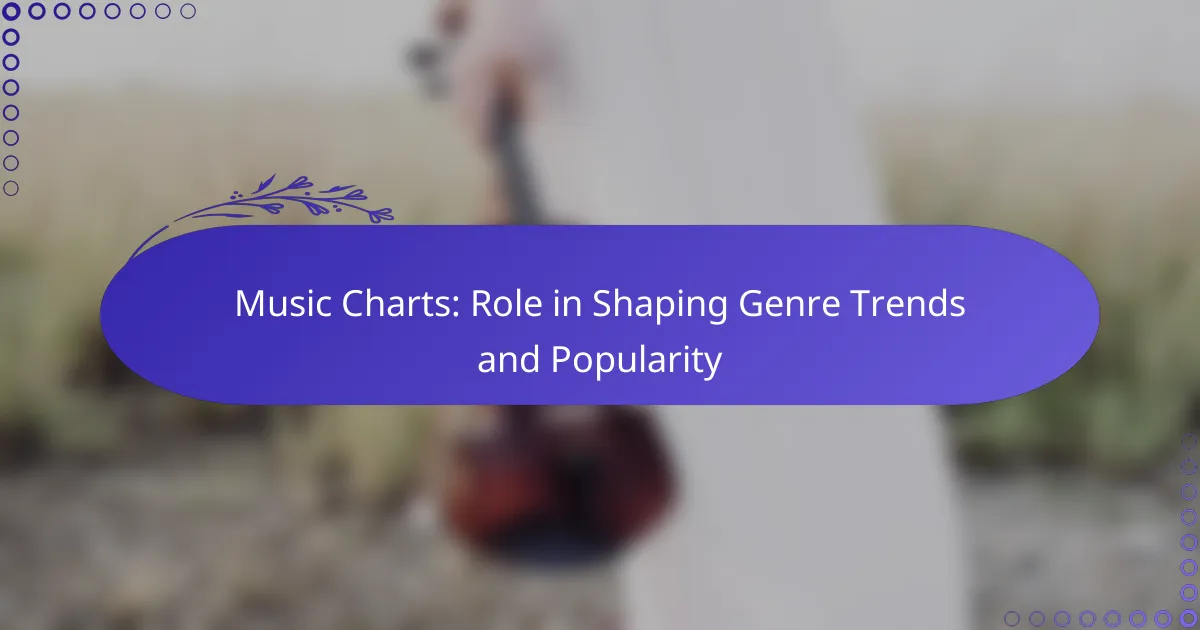Music charts play a crucial role in shaping genre trends and determining the popularity of songs and artists in the industry. By reflecting consumer preferences, these charts not only influence which genres gain traction but also guide artists in adapting their styles to align with market demands. Additionally, the rise of streaming platforms has further transformed music charts, impacting visibility and engagement through algorithms that dictate what listeners discover and enjoy.
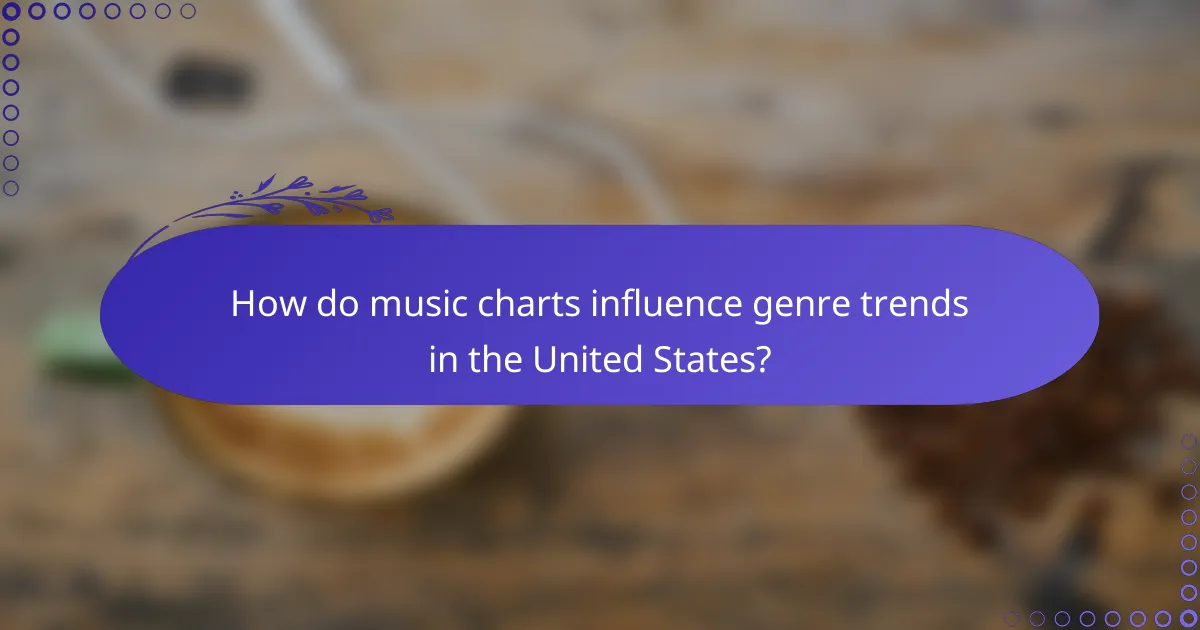
How do music charts influence genre trends in the United States?
Music charts significantly shape genre trends in the United States by reflecting consumer preferences and driving industry focus. As songs and albums rise and fall on these charts, they influence what genres gain popularity and how artists adapt their styles to meet market demands.
Billboard Hot 100 impact on pop music
The Billboard Hot 100 is a key indicator of what is trending in pop music, as it ranks the most popular songs based on sales, radio play, and streaming data. Songs that achieve high positions often set the tone for emerging pop trends, encouraging artists to adopt similar sounds or themes.
For instance, when a particular style, such as tropical house or trap, gains traction on the Hot 100, it can lead to a surge of similar tracks being produced. This phenomenon can create a cycle where certain genres dominate the charts, influencing both listeners and creators alike.
Billboard 200 effect on album genres
The Billboard 200 ranks the most popular albums in the U.S., impacting the genres that receive attention and investment. Albums that perform well can lead to increased visibility for specific genres, prompting record labels to promote similar artists or sounds.
For example, if a hip-hop album reaches the top of the Billboard 200, it may inspire a wave of new hip-hop releases, as labels seek to capitalize on the genre’s popularity. This trend can shift the musical landscape, making certain styles more mainstream and accessible to a broader audience.
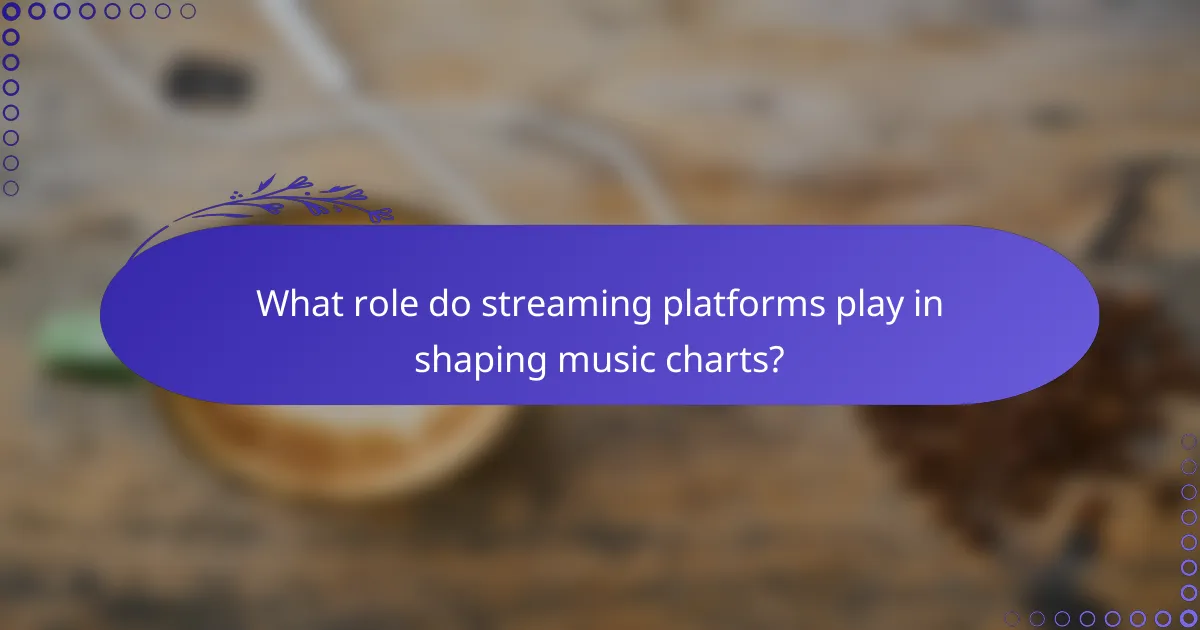
What role do streaming platforms play in shaping music charts?
Streaming platforms significantly influence music charts by determining which songs gain visibility and popularity. Their algorithms and user engagement metrics help shape genre trends, impacting what listeners discover and enjoy.
Spotify charts and genre popularity
Spotify charts reflect real-time listening habits, showcasing the most popular tracks across various genres. The platform’s algorithm promotes songs based on user playlists, skips, and shares, which can rapidly elevate certain genres to mainstream status.
For example, if a particular genre like lo-fi hip-hop gains traction on Spotify, it may lead to increased production and releases in that style. Artists often analyze these charts to identify trends and adjust their music accordingly, ensuring they remain relevant in a competitive landscape.
Apple Music’s influence on emerging artists
Apple Music plays a crucial role in promoting emerging artists through curated playlists and exclusive releases. By featuring new talent on popular playlists, Apple Music can significantly boost an artist’s exposure and streaming numbers.
For instance, when an up-and-coming artist is included in a prominent playlist, they may see a surge in listeners and followers, often translating into higher chart positions. This platform’s focus on quality curation helps shape genre trends by spotlighting innovative sounds and styles that resonate with audiences.
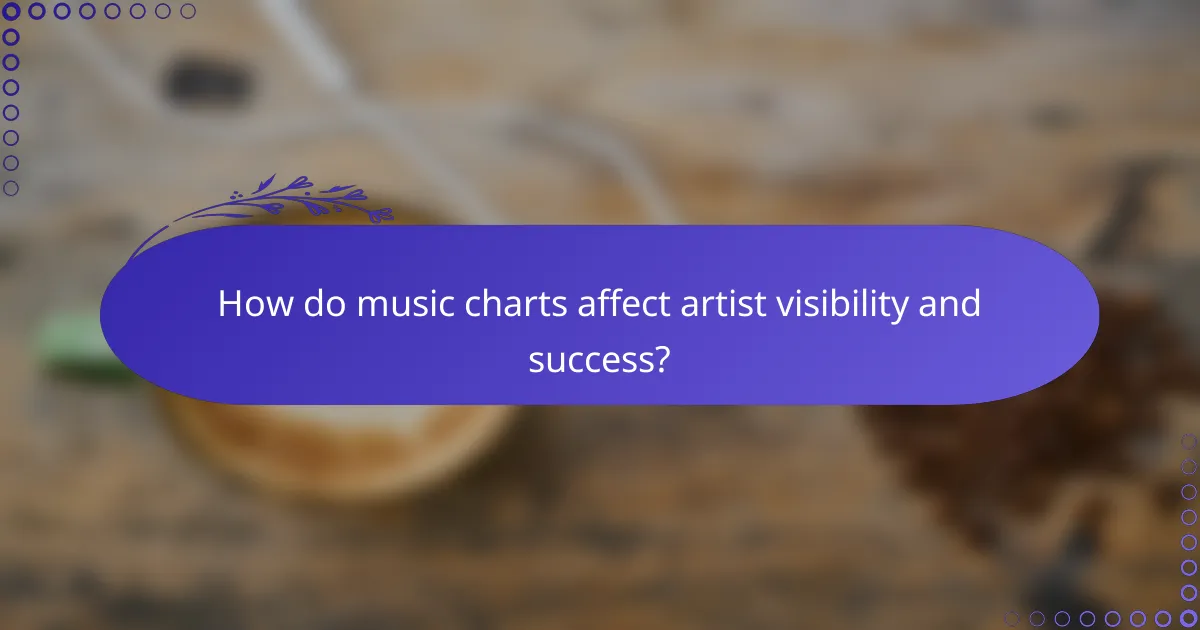
How do music charts affect artist visibility and success?
Music charts significantly influence artist visibility and success by determining which songs gain exposure and reach wider audiences. Higher chart positions often lead to increased streaming, sales, and radio play, which can propel an artist’s career forward.
Chart rankings and radio play correlation
Chart rankings are closely linked to radio play, as songs that perform well on charts typically receive more airtime. This increased exposure can create a feedback loop, where higher radio play boosts chart positions further, enhancing an artist’s overall visibility.
For example, a song that enters the top 10 may receive dozens of spins per day on popular radio stations, while a song outside the top 40 might struggle to get any airplay. This correlation highlights the importance of chart performance in securing radio opportunities.
Impact on touring and live performances
Successful chart performance can directly affect an artist’s touring potential and live performances. Artists with high chart rankings often experience increased demand for concert tickets, leading to larger venues and more lucrative tour deals.
For instance, an artist whose single reaches the top of the charts may find themselves headlining major festivals or selling out arenas, while those with lower chart positions might only secure smaller venues. This disparity can significantly impact an artist’s revenue and brand visibility.
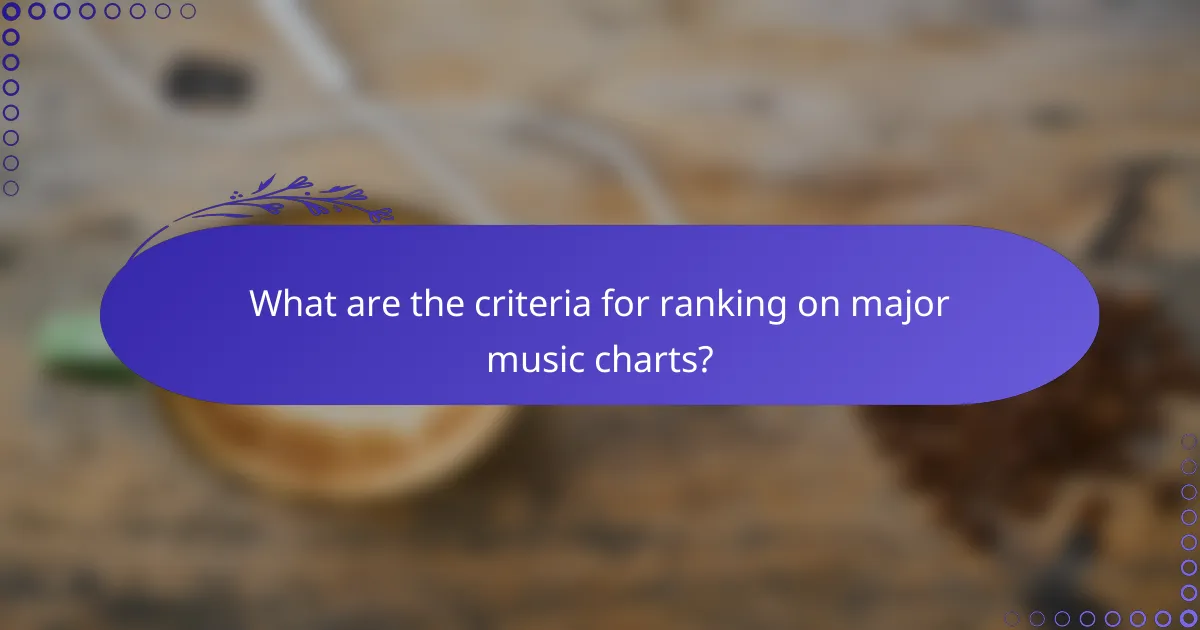
What are the criteria for ranking on major music charts?
Major music charts rank songs based on a combination of sales data, streaming metrics, radio airplay, and social media engagement. These criteria help determine a song’s popularity and influence within the music industry.
Sales data and streaming metrics
Sales data includes both physical and digital purchases of songs and albums, while streaming metrics reflect how often a song is played on platforms like Spotify and Apple Music. Typically, a song’s chart position can be significantly influenced by its sales figures, especially during the first week of release.
For example, a song that sells tens of thousands of copies in its debut week is likely to secure a higher ranking. Streaming counts are increasingly important, with some charts now weighing streams more heavily than traditional sales.
Radio airplay and social media engagement
Radio airplay measures how frequently a song is played on radio stations, which can greatly enhance its visibility and popularity. Charts often consider airplay data from a wide range of stations, reflecting both local and national trends.
Social media engagement, including shares, likes, and comments on platforms like Instagram and TikTok, also plays a crucial role in a song’s ranking. A viral trend or challenge can propel a song to the top of the charts, demonstrating the power of digital platforms in shaping music trends.
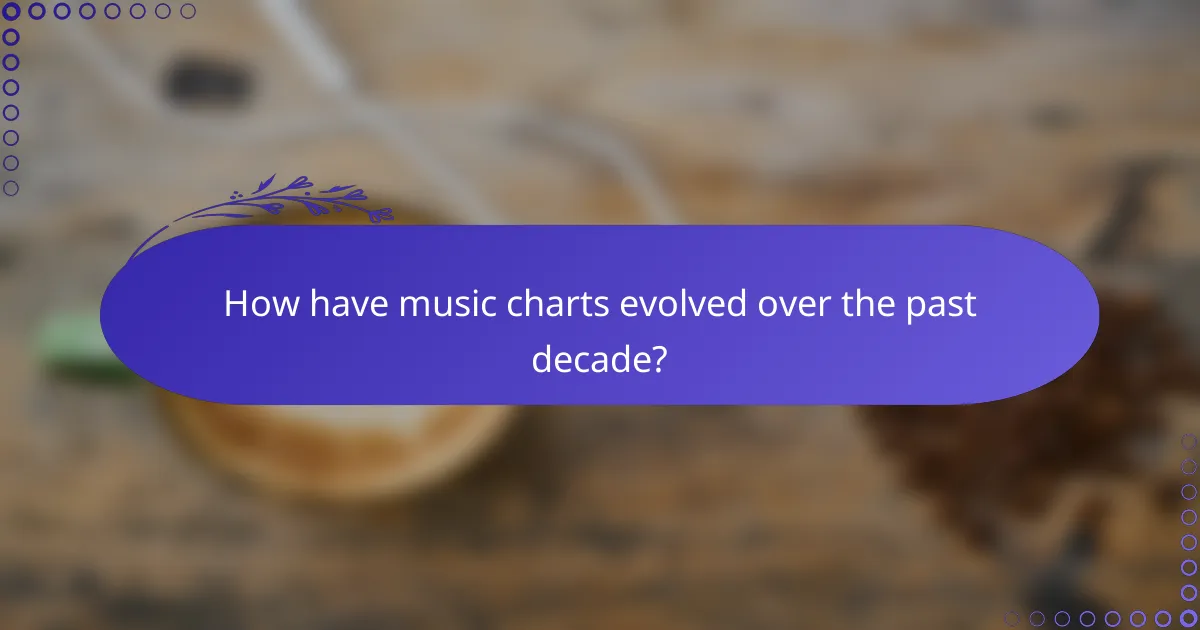
How have music charts evolved over the past decade?
Over the past decade, music charts have transformed significantly, reflecting changes in how music is consumed and measured. The rise of digital platforms and social media has reshaped the landscape, influencing genre trends and the popularity of artists.
Shift from physical sales to digital consumption
The transition from physical sales to digital consumption has been a defining change in music charts. In the early 2010s, physical album sales dominated, but by the end of the decade, streaming services like Spotify and Apple Music accounted for the majority of music consumption. This shift has led to a more dynamic and immediate reflection of listener preferences.
As a result, charts now prioritize streaming numbers and digital downloads over traditional sales. For example, Billboard’s Hot 100 incorporates streaming data, allowing songs to rise quickly based on online popularity rather than just sales figures. This change has made it essential for artists to engage with digital platforms to maintain chart presence.
Integration of social media metrics
Social media metrics have become increasingly important in shaping music charts. Platforms like TikTok and Instagram can propel songs to viral status, impacting their chart performance. Tracks that gain traction on these platforms often see a corresponding boost in streaming and downloads, which directly influences their ranking.
This integration means that artists must now consider their social media presence as part of their marketing strategy. Engaging with fans through platforms can lead to increased visibility and chart success. However, relying solely on social media trends can be risky, as viral moments may not always translate into long-term popularity.
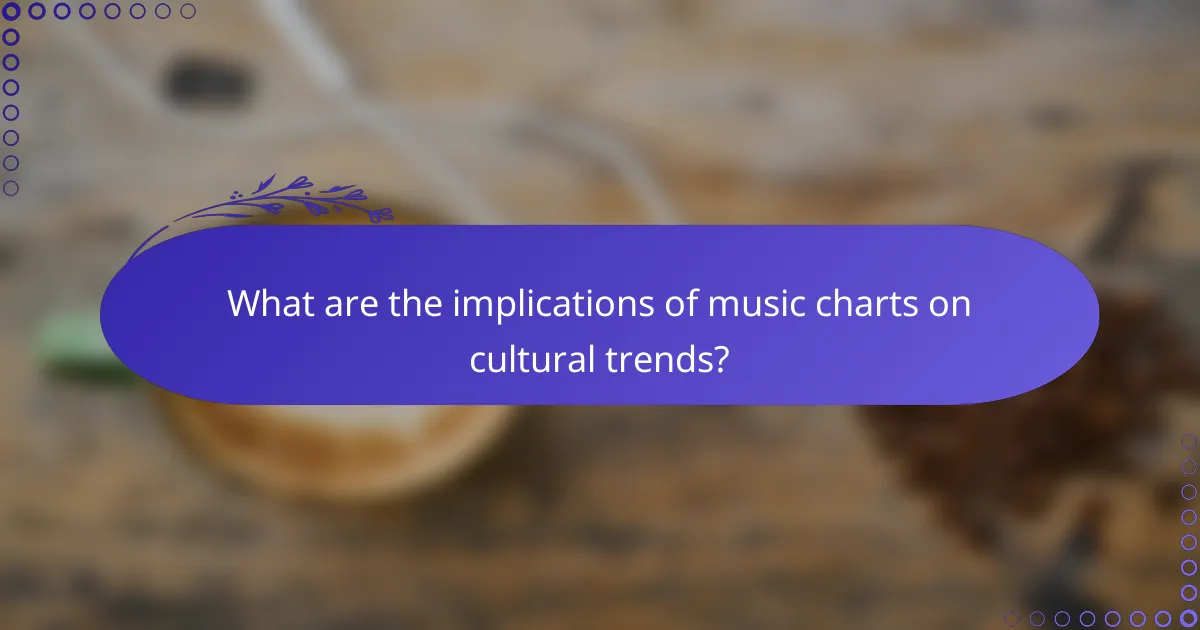
What are the implications of music charts on cultural trends?
Music charts significantly influence cultural trends by shaping public taste and determining which genres gain popularity. They serve as a barometer for what is trending, often guiding artists and producers in their creative decisions.
Influence on fashion and lifestyle
Music charts often dictate fashion trends, as popular artists become style icons. For example, when a particular genre, like hip-hop, dominates the charts, associated fashion elements such as streetwear and luxury brands see a surge in popularity.
Additionally, lifestyle choices are influenced by chart-topping music. Fans may adopt the habits or attitudes expressed in songs, leading to shifts in social behaviors, such as increased interest in nightlife or specific social events.
Reflection of societal issues through music
Music charts can reflect pressing societal issues, as artists often address topics like inequality, mental health, and political unrest in their lyrics. When these themes resonate with listeners, they can propel songs to the top of the charts, highlighting the public’s concerns.
For instance, songs that tackle social justice issues may gain traction during movements, influencing public discourse and encouraging activism. This interplay between music and societal issues underscores the power of charts in shaping cultural narratives.
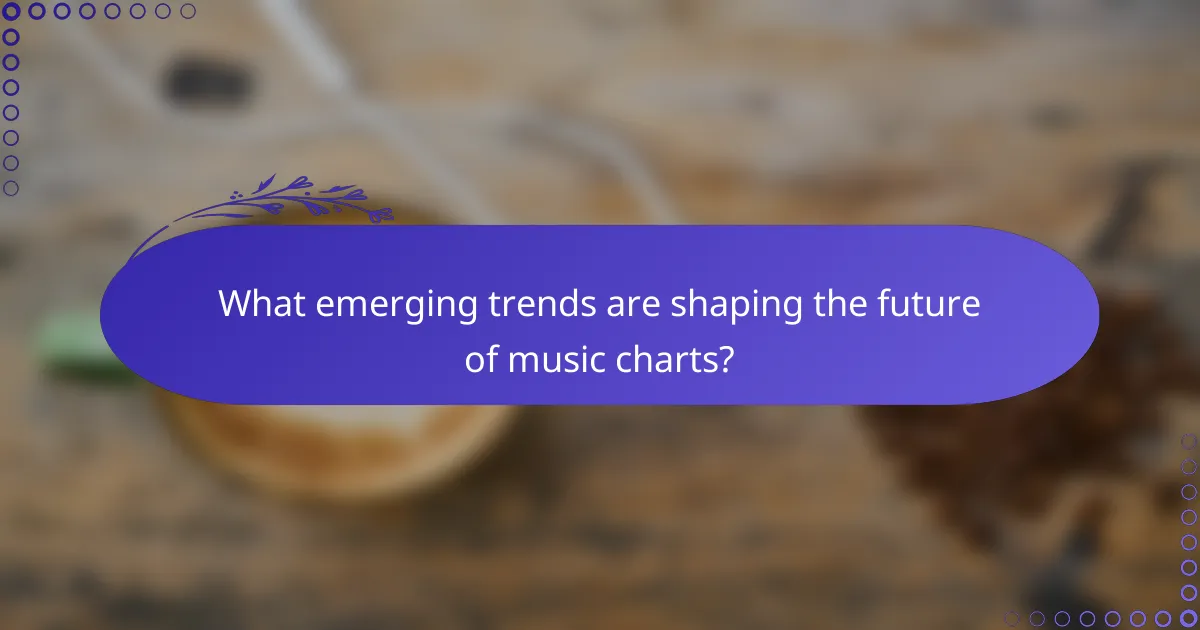
What emerging trends are shaping the future of music charts?
Emerging trends in music charts are increasingly influenced by digital platforms, social media, and evolving listener preferences. These factors are reshaping how genres gain popularity and how artists connect with their audiences.
The impact of streaming services on music charts
Streaming services like Spotify and Apple Music have revolutionized music consumption, significantly affecting music charts. These platforms allow for real-time tracking of song popularity, making it easier for emerging artists to gain visibility and for listeners to discover new genres.
As a result, charts are now more reflective of current trends, with songs often climbing rapidly based on viral moments or playlists. This shift encourages artists to create music that resonates with digital audiences, often leading to shorter song lengths and catchy hooks.
Social media’s role in shaping music trends
Social media platforms, particularly TikTok and Instagram, play a crucial role in shaping music trends and influencing chart performance. Viral challenges or trends can propel a song to the top of the charts almost overnight, demonstrating the power of user-generated content.
Artists are increasingly leveraging these platforms for promotion, often releasing snippets of songs to gauge audience reaction before full releases. This strategy can lead to more targeted marketing efforts and increased engagement with fans.
Genre blending and its effects on popularity
Genre blending is becoming more prevalent, with artists combining elements from different styles to create unique sounds. This trend not only broadens the appeal of individual songs but also influences chart rankings as listeners seek out diverse musical experiences.
For example, the fusion of hip-hop and pop has led to numerous chart-topping hits, showcasing how artists can reach wider audiences by experimenting with their sound. This blending encourages innovation and keeps the music landscape dynamic.
The rise of independent artists and DIY culture
The rise of independent artists and the DIY culture is reshaping music charts by challenging traditional industry norms. Many artists are now self-releasing music and using social media to build their fan bases, which can lead to unexpected chart success.
This trend highlights the importance of authenticity and direct artist-to-fan relationships. Independent artists often rely on grassroots marketing strategies, which can resonate more with listeners and lead to sustained popularity on charts.
